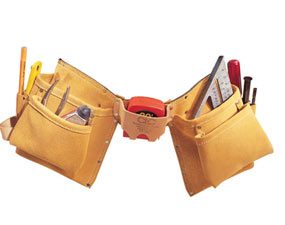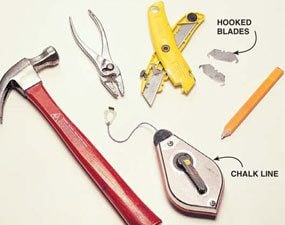Organizing a Tool Belt
Updated: Jun. 30, 2017A $30 tool belt, organized with the proper tools, allows you to work faster with better results.

Why wear a tool belt?
Watching well-organized pros or do-it-yourselfers work in harmony with their tool belts is a study in skill, efficiency and “poetic glide.” Their tasks speed along as they intuitively reach into a pouch and grab the exact tool or fastener needed for the task. Without taking their eyes off their work, they send the tool to its pocket and the next one effortlessly appears in hand. The “dominant hand”—controlling the hammer, knife and pencil—orchestrates the operation, while the “helper hand” responds by bringing the appropriate fastener or accessory tool instantly into play. Whether you work on your house once a week or once a month, this is a logical rhythm you can learn. We’ll show you the layout plan of a tool belt and the hand tools many pros carry, and explain why you should copy them.
I used to work alongside many homeowners who hated to wear tool belts. They hated the weight and resented having poorly stowed tools snag on ladders and scaffolding. The trade-off was constant interruptions to fetch what they needed from the other side of a room, rather than have the hand tools and fasteners they needed right there with them.
Habitually, these tool belt haters would:
- Make umpteen unnecessary trips from the roof to the ground hauling tools.
- Stuff the fasteners they needed in their pants and shirt pockets.
- Hand-carry their small tools.
- Waste lots of time looking for tools and fasteners they’d placed “somewhere.”
Compared with the tool belt masters, tool belt haters invariably seem crabby and struggle with their work. Speed, performance and safety all improve with the right tool belt, loaded the right way.
Tip 1: Buy a tool belt with lots of pockets
Buy a tool belt With lots of pockets for carrying various fasteners and the hand tools shown. The web belt on this model fastens in the back, with the tape measure in front, available for either hand. This is a setup for a right-hand belt, meaning the tools favored by the dominant hand (the one you hammer and write with) are set up on the right-hand side of the tool belt.
Tip 2: Tools for the dominant hand
Dominant-hand tools are the primary task drivers. A good, general-duty claw hammer should weigh 12 or 16 oz. and be a balance of comfort, control and maximum nail-driving power. A flat carpenter’s pencil won’t break as easily as an ordinary round one and works best for rough carpentry work. A chalk line is a must for snapping long, straight lines. It’s also essential as a plumb bob or string line. A slip-joint pliers is a versatile tool for pulling nails and for simple electrical and plumbing work. The utility knife is a must for everything from cutting drywall to roofing work and should have extra blades, both straight and curved, stored in the handle.
Tip 3: Tools for the helper hand
Helper-hand tools are accessories that work in combination with a hammer or pencil and are stored on the opposite side of the tool belt. For this right-handed tool user, these are the helper hand tools. Two nail sets, a 1/8-in. one for large nails plus a 1/16-in. one for finish nails. A cold chisel for doing plaster and concrete demolition work, bludgeoning fasteners and prying stuff. A four-in-one screwdriver, which consists of two sizes each of Phillips bits and straight blades. This tool could be used by either hand and is stored (if you choose) with the chisel. Fasteners are best carried in the pouches opposite the hammer hand so that the helper hand can smoothly feed nails as the hammer drives them. A square works in tandem with pencils for drawing saw cutting lines and other lumber layouts.
Tip 4: Reverse the belt for speed and comfort
Increase comfort and efficiency when working bent over for long periods by turning the belt around and either rearranging your fasteners and hand tools or learning the new locations. Working with the tool belt in its regular front-facing position while building walls is a pain. The tape measure pouch cuts into your waist and bending makes it more difficult to grab fasteners and tools out of the pinched-shut pouches.
Tip 5: Climb ladders more safely
Climb ladders safely without dropping your tools by using tool belt accessories such as drill carriers. Take advantage of belt waistbands as a place to stash more tools within easy reach when working either on or off ladders.
Tip 6: Save your back
Wearing a tool belt for a long time takes a toll on your back. Some strain prevention strategies:
- Invest about $12 and use wide band suspenders (Photo 6) to distribute the load across more of your body. Suspenders can be used with any type of leather or nylon tool belt. Periodically replace suspenders that become stretched and lose their elasticity.
- Use a nylon padded belt (about $27). Padded belts cushion the weight of tool bags and provide back support as you lug building materials.
Note: Padded belts can’t be used with tool belts that have permanently fastened front-facing pouches. - Wear tool vests for the ultimate in ergonomic comfort. For a snappy look that’ll have the neighbors talking, take out the tools and wear the vest over a dress shirt.
Find the Best Tool Belt for the Work You Do
Home centers and better hardware stores carry such an assortment of tool belts and accessories that it’s easy to start imagining yourself as the lead carpenter on a TV home improvement show. Before you get carried away, determine which skill level you fall into:
- For the pro, the belt is a tool in itself. A good choice is one with two independent pouches (Photo 6) that ride on each hip so you aren’t pinched in the waist when you bend over. Outfitted with drill carriers, hammer loops and lots of compartments to customize, this higher priced rig makes sense for a pro, but not the occasional handyperson.
- The serious do-it-yourselfer would find a leather tool belt with double front-facing pouches (Photo 1) an affordable, logical choice. It’s durable and has plenty of pockets to arrange often-used tools.
- For occasional do-it-yourselfers, a sturdy, inexpensive cloth nail apron is just the ticket. Made with a web hammer loop attached to each side and an assortment of large and small pockets, it’s quite sufficient to carry the key hand tools and fasteners to tackle their projects.
Whichever rig you choose, decrease your “go-fer” time during the workday by visualizing your tasks in advance so you can properly load up your tool belt or nail apron. Working effectively is not a privilege reserved only for professionals.










